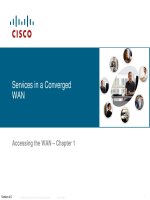Accessing the WAN – Chapter 2 docx
Bạn đang xem bản rút gọn của tài liệu. Xem và tải ngay bản đầy đủ của tài liệu tại đây (2.72 MB, 61 trang )
© 2006 Cisco Systems, Inc. All rights reserved. Cisco Public ITE I Chapter 6
1
Point-to-Point Protocol
Accessing the WAN – Chapter 2
Cisco Thai Nguyen Networking Academy
© 2006 Cisco Systems, Inc. All rights reserved. Cisco Public ITE 1 Chapter 6
2
Objectives
In this chapter, you will learn to:
– Describe the fundamental concepts of point-to-point serial
communication.
– Describe key PPP concepts.
– Configure PPP encapsulation.
– Explain and configure PAP and CHAP authentication.
Cisco Thai Nguyen Networking Academy
© 2006 Cisco Systems, Inc. All rights reserved. Cisco Public ITE 1 Chapter 6
3
How Does Serial Communication Work?
Most PCs have both serial and parallel ports.
Computers use of relatively short parallel connections
between interior components, but use a serial bus to
convert signals for most external communications.
–With a serial connection, information is sent across one
wire, one data bit at a time.
•The 9-pin serial connector on most PCs uses two loops of
wire, one in each direction, for data communication, plus
additional wires to control the flow of information.
–A parallel connection sends the bits over more wires
simultaneously. In the 25-pin parallel port on your PC,
there are 8 data wires to carry 8 bits simultaneously.
•The parallel link theoretically transfers data eight times
faster than a serial connection.
In reality, it is often the case that serial links can be
clocked considerably faster than parallel links, and
they achieve a higher data rate
–Two factors that affect parallel communications: clock
skew and crosstalk interference.
Cisco Thai Nguyen Networking Academy
© 2006 Cisco Systems, Inc. All rights reserved. Cisco Public ITE 1 Chapter 6
4
Parallel connection: Clock Skew & Interference
In a parallel connection, it is wrong to assume
that the 8 bits leaving the sender at the same
time arrive at the receiver at the same time.
Clock Skew
–Some of the bits get there later than others. This
is known as clock skew.
–Overcoming clock skew is not trivial. The
receiving end must synchronize itself with the
transmitter and then wait until all the bits have
arrived. The process of reading, waiting, waiting
adds time to the transmission.
–This is not a factor with serial links, because most
serial links do not need clocking.
Interference
–Parallel wires are physically bundled in a parallel
cable. The possibility of crosstalk across the wires
requires more processing.
–Since serial cables have fewer wires, there is less
crosstalk, and network devices transmit serial
communications at higher, more efficient
frequencies.
Cisco Thai Nguyen Networking Academy
© 2006 Cisco Systems, Inc. All rights reserved. Cisco Public ITE 1 Chapter 6
5
Serial Communication Standards
In a serial communication process.
–Data is encapsulated by the sending router.
–The frame is sent on a physical medium to the WAN.
–There are various ways to traverse the WAN,
–The receiving router uses the same communications
protocol to de-encapsulate the frame when it arrives.
There are three key serial communication standards
affecting LAN-to-WAN connections:
–RS-232 - Most serial ports on personal computers conform
to the RS-232C standards.
•Both 9-pin and 25-pin connectors are used.
•It be used for device, including modems, mice, and printers.
–V.35 – It is used for modem-to-multiplexer communication.
•V.35 is used by routers and DSUs that connect to T1 carriers.
–HSSI - A High-Speed Serial Interface (HSSI) supports
transmission rates up to 52 Mb/s.
•HSSI is used to connect routers on LANs with WANs over high-
speed lines such as T3 lines.
Cisco Thai Nguyen Networking Academy
© 2006 Cisco Systems, Inc. All rights reserved. Cisco Public ITE 1 Chapter 6
6
Serial Communication: RS-232
While this course does not examine the details of V.35 and
HSSI pinning schemes, a quick look at a 9-pin RS-232
connector used to connect a PC to a modem helps illustrate
the concept.
–Pin 1 - Data Carrier Detect (DCD) indicates that the carrier for the
transmit data is ON.
–Pin 2 - The receive pin (RXD) carries data from the serial device to
the computer.
–Pin 3 - The transmit pin (TxD) carries data from the computer to
the serial device.
–Pin 4 - Data Terminal Ready (DTR) indicates to the modem that
the computer is ready to transmit.
–Pin 5 - Ground
–Pin 6 - Data Set Ready (DSR) is similar to DTR. It indicates that
the Dataset is ON.
–Pin 7 - The RTS pin requests clearance to send data to a modem
–Pin 8 - The serial device uses the Clear to Send (CTS) pin to
acknowledge the RTS signal of the computer. In most situations,
RTS and CTS are constantly ON throughout the communication
session.
–Pin 9 - An auto answer modem uses the Ring Indicator (RI) to
signal receipt of a telephone ring signal.
Cisco Thai Nguyen Networking Academy
© 2006 Cisco Systems, Inc. All rights reserved. Cisco Public ITE 1 Chapter 6
7
Time Division Multiplexing (TDM)
Bell Laboratories invented TDM to maximize the
amount of voice traffic carried over a medium.
Compare TDM to a train with 32 railroad cars.
–Each car is owned by a different freight company,
and every day the train leaves with the 32 cars
attached.
–If the companies has cargo to send, the car is
loaded.
–If the company has nothing to send, the car
remains empty but stays on the train.
–Shipping empty containers is not very efficient.
–TDM shares this inefficiency when traffic is
intermittent, because the time slot is still allocated
even when the channel has no data to transmit.
Cisco Thai Nguyen Networking Academy
© 2006 Cisco Systems, Inc. All rights reserved. Cisco Public ITE 1 Chapter 6
8
Time Division Multiplexing (TDM)
TDM divides the bandwidth of a single link into
separate channels or time slots.
–TDM transmits two or more channels over the
same link by allocating a different time interval (time
slot) for the transmission of each channel.
–TDM is a physical layer concept. It has no regard
of the information that is being multiplexed.
The multiplexer (MUX) accepts input from
attached devices in a round-robin fashion and
transmits the data in a never-ending pattern.
–The MUX puts each segment into a single channel
by inserting each segment into a timeslot.
–A MUX at the receiving end separate data streams
based only on the timing of the arrival of each bit.
– A technique called bit interleaving keeps track of
the sequence of the bits so that they can be
efficiently reassembled into their original form upon
receipt.
Cisco Thai Nguyen Networking Academy
© 2006 Cisco Systems, Inc. All rights reserved. Cisco Public ITE 1 Chapter 6
9
Statistical Time Division Multiplexing
Statistical time-division multiplexing
(STDM) was developed to overcome this
inefficiency.
–STDM uses a variable time slot length allowing
channels to compete for any free slot space.
–It employs a buffer memory that temporarily
stores the data during periods of peak traffic.
–STDM does not waste high-speed line time
with inactive channels using this scheme.
–STDM requires each transmission to carry
identification information (a channel identifier).
Cisco Thai Nguyen Networking Academy
© 2006 Cisco Systems, Inc. All rights reserved. Cisco Public ITE 1 Chapter 6
10
TDM Examples - ISDN and SONET
An example of a technology that uses synchronous
TDM is ISDN.
–ISDN basic rate (BRI) has three channels consisting of
two 64 kb/s B-channels (B1 and B2), and a 16 kb/s D-
channel.
–The TDM has nine timeslots, which are repeated in the
sequence shown in the figure.
On a larger scale, the industry uses the SONET or
SDH for optical transport of TDM data.
–SONET, used in North America, and SDH, used
elsewhere, for synchronous TDM over fiber.
–SONET/SDH takes n bit streams, multiplexes them,
and optically modulates the signal, sending it out using a
light emitting device over fiber with a bit rate equal to
(incoming bit rate) x n. Thus traffic arriving at the
SONET multiplexer from four places at 2.5 Gb/s goes
out as a single stream at 4 x 2.5 Gb/s, or 10 Gb/s.
SDH - Synchronous Digital Hierarchy
SONET - Synchronous optical networking
Cisco Thai Nguyen Networking Academy
© 2006 Cisco Systems, Inc. All rights reserved. Cisco Public ITE 1 Chapter 6
11
TDM Examples - T-Carrier Hierarchy
DS0: The original unit used in multiplexing
telephone calls is 64 kb/s, which represents one
phone call.
T1: In North America, 24 DS0 units are
multiplexed using TDM into a higher bit-rate
signal with an aggregate speed of 1.544 Mb/s
for transmission over T1 lines.
–While it is common to refer to a 1.544 Mb/s
transmission as a T1, it is more correct to refer to
it as DS1.
–T-carrier refers to the bundling of DS0s.
–A T1 = 24 DSOs,
–A T1C = 48 DSOs (or 2 T1s), and so on.
E1: Outside North America, 32 DS0 units are
multiplexed for E1 transmission at 2.048 Mb/s.
Cisco Thai Nguyen Networking Academy
© 2006 Cisco Systems, Inc. All rights reserved. Cisco Public ITE 1 Chapter 6
12
Demarcation Point
The demarcation point marks the point where your
network interfaces with the network owned by another
organization.
–This is the interface between customer-premises
equipment (CPE) and network service provider equipment.
–The demarcation point is the point in the network where
the responsibility of the service provider ends.
The example presents an ISDN scenario.
–In the United States, a service provider provides the local
loop into the customer premises,
•The customer provides the active equipment such as the
channel service unit/data service unit (CSU/DSU) on which the
local loop is terminated.
•The customer is responsible for maintaining, replacing, or
repairing the equipment.
–In other countries, the network terminating unit (NTU) is
provided and managed by the service provider.
•The customer connects a CPE device, such as a router or
frame relay access device, to the NTU using a V.35 or RS-232
serial interface.
Cisco Thai Nguyen Networking Academy
© 2006 Cisco Systems, Inc. All rights reserved. Cisco Public ITE 1 Chapter 6
13
DTE and DCE
In order to be connecting to the WAN, a serial
connection has a DTE device at one end of the
connection and a DCE device at the other end.
–The DTE, which is generally a router.
•The DTE could also be a terminal, computer, printer,
or fax machine.
–The DCE, commonly a modem or CSU/DSU, is
the device used to convert the user data from the
DTE into a form acceptable to the WAN service
provider transmission link.
•This signal is received at the remote DCE, which
decodes the signal back into a sequence of bits.
•The remote DCE then signals this sequence to the
remote DTE.
The connection between the two DCE devices is
the WAN service provider transmission network.
Cisco Internal T1 CSU/DSU
WIC-1DSU-T1
Cisco Thai Nguyen Networking Academy
© 2006 Cisco Systems, Inc. All rights reserved. Cisco Public ITE 1 Chapter 6
14
DTE and DCE
DTE and DCE Cable Standards
–Originally, the concept of DCEs and DTEs was based on
two types of equipment: terminal equipment that
generated or received data, and communication
equipment that only relayed data.
–We are left with two different types of cables:
•one for connecting a DTE to a DCE,
•another for connecting two DTEs directly to each other.
The DTE/DCE interface standard defines the following
specifications:
–Mechanical/physical - Number of pins and connector type
–Electrical - Defines voltage levels for 0 and 1
–Functional - Specifies the functions that are performed by
assigning meanings to each of the signaling lines in the interface
–Procedural - Specifies the sequence for transmitting data
The Serial Cables
–The original RS-232 standard only defined the
connection of DTEs with DCEs, which were modems.
–A null modem is a communication method to directly
connect two DTEs, such as a computer, terminal, or
printer, using a RS-232 serial cable. With a null modem
connection, the transmit (Tx) and receive (Rx) lines are
crosslinked.
Cisco Thai Nguyen Networking Academy
© 2006 Cisco Systems, Inc. All rights reserved. Cisco Public ITE 1 Chapter 6
15
DTE and DCE
The DB-60 Connector
–The cable for the DTE to DCE connection is a
shielded serial cable. The router end of the serial
cable may be a DB-60 connector.
•The other end of the serial transition cable is
available with the connector appropriate for the
standard that is to be used.
The Smart Serial Connector
–To support higher port densities in a smaller form
factor, Cisco has introduced a Smart Serial cable.
•The router interface end of the Smart Serial cable is
a 26-pin connector that is significantly more compact
than the DB-60 connector.
The Router-to-Router
–When using a null modem, keep in mind that
synchronous connections require a clock signal.
–When using a null modem cable in a router-to-
router connection, one of the serial interfaces
must be configured as the DCE end to provide the
clock signal for the connection.
Cisco Thai Nguyen Networking Academy
© 2006 Cisco Systems, Inc. All rights reserved. Cisco Public ITE 1 Chapter 6
16
DTE and DCE: Parallel to Serial Conversion
The terms DTE and DCE are relative with respect to
what part of a network you are observing.
–RS-232C is the recommended standard (RS)
describing the physical interface and protocol for
relatively low-speed, serial data communication between
computers and related devices.
•The DTE is the RS-232C interface that a computer uses to
exchange data with a modem or other serial device.
•The DCE is the RS-232C interface that a modem or other
serial device uses in exchanging data with the computer.
Your PC also has a Universal Asynchronous
Receiver/Transmitter (UART) chip on the
motherboard. The UART is the DTE agent of your PC
and communicates with the modem or other serial
device, which, in accordance with the RS-232C
standard, has a complementary interface called the
DCE interface.
–The data in your PC flows along parallel circuits, the
UART chip converts the groups of bits in parallel to a
serial stream of bits.
Cisco Thai Nguyen Networking Academy
© 2006 Cisco Systems, Inc. All rights reserved. Cisco Public ITE 1 Chapter 6
17
WAN Encapsulation Protocols
On WAN connection, data is encapsulated into frames
before crossing the WAN link. The protocol depends on the
WAN technology and communicating equipment:
–HDLC - The default encapsulation type on point-to-point
connections, when the link uses two Cisco devices.
–PPP - Provides router-to-router and host-to-network
connections over synchronous and asynchronous circuits.
•PPP works with several network protocols, such as IP and IPX. PPP
also has built-in security mechanisms such as PAP and CHAP.
–Serial Line Internet Protocol (SLIP) - A standard protocol for
point-to-point serial connections using TCP/IP.
•SLIP has been largely displaced by PPP.
–X.25/Link Access Procedure, Balanced (LAPB) - X.25 specifies
LAPB, a data link layer protocol.
•X.25 is a predecessor to Frame Relay.
–Frame Relay - Frame Relay eliminates some of the time-
consuming processes (such as error correction and flow control)
employed in X.25.
–ATM - The cell relay in which devices send multiple service
types (voice, video, or data) in fixed-length (53-byte) cells.
•Fixed-length cells allow processing to occur in hardware, thereby
reducing transit delays.
With SLIP, you have to know
the IP address assigned to you
by your service provider. You
also need to know the IP
address of the remote system
you will be dialing into. You
may also need to configure such
details as MTU (maximum
transmission unit), MRU
(maximum receive unit), etc.
Cisco Thai Nguyen Networking Academy
© 2006 Cisco Systems, Inc. All rights reserved. Cisco Public ITE 1 Chapter 6
18
HDLC Encapsulation
HDLC is a bit-oriented synchronous data link layer
protocol developed by the International Organization
for Standardization (ISO).
–HDLC was developed from the Synchronous Data Link
Control (SDLC) standard proposed in the 1970s.
–HDLC provides both connection-oriented and
connectionless service.
–HDLC defines a Layer 2 framing structure that allows
for flow control and error control through the use of
acknowledgments.
–HDLC uses a frame delimiter, or flag, to mark the
beginning and the end of each frame.
Cisco has developed an extension to the HLDC
protocol to solve the inability to provide multiprotocol
support.
–Cisco HLDC (also referred to as cHDLC) is proprietary
–Cisco HDLC frames contain a field for identifying the
network protocol being encapsulated.
Cisco Thai Nguyen Networking Academy
© 2006 Cisco Systems, Inc. All rights reserved. Cisco Public ITE 1 Chapter 6
19
HLDC Frame Types
Flag - The flag field initiates and terminates error checking.
–The frame always starts and ends with an 8-bit flag field. The
bit pattern is 01111110.
Address - The address field contains the HDLC address of
the secondary station.
–This address can contain a specific address, a group address,
or a broadcast address.
Control - HDLC defines three types of frames, each with a
different control field format:
–Information (I) frame: I-frames carry upper layer information and
some control information.
–Supervisory (S) frame: S-frames provide control information.
–Unnumbered (U) frame: U-frames support control purposes and
are not sequenced.
Protocol - (only in Cisco HDLC) It specifies the protocol type
encapsulated within the frame (e.g. 0x0800 for IP).
Data - The data field contains a path information unit (PIU)
or exchange identification (XID) information.
Frame check sequence (FCS) - The FCS precedes the
ending flag delimiter and is usually a cyclic redundancy
check (CRC) calculation remainder.
Cisco Thai Nguyen Networking Academy
© 2006 Cisco Systems, Inc. All rights reserved. Cisco Public ITE 1 Chapter 6
20
Configuring HDLC Encapsulation
Cisco HDLC is the default encapsulation method
used by Cisco devices on synchronous serial lines.
–You use Cisco HDLC as a point-to-point protocol on
leased lines between two Cisco devices.
–If the default encapsulation method has been changed,
use the encapsulation hdlc command in privileged mode
to re-enable HDLC.
If you are connecting to a non-Cisco device, use
synchronous PPP.
There are two steps to enable HDLC encapsulation:
–Step 1. Enter the interface configuration mode of the
serial interface.
–Step 2. Enter the encapsulation hdlc command to
specify the encapsulation protocol on the interface.
The output of the show interfaces serial command
displays information specific to serial interfaces.
When HDLC is configured, "Encapsulation HDLC"
Cisco Thai Nguyen Networking Academy
© 2006 Cisco Systems, Inc. All rights reserved. Cisco Public ITE 1 Chapter 6
21
Troubleshooting a serial interface
Show ip int brief (sh ip int b)
Router# show ip interface brief
Interface IP-Address OK? Method Status Protocol
Ethernet0 131.108.1.11 YES manual up up
Serial0 198.135.2.49 YES manual administratively down down
Serial x is down, line protocol is down
Serial x is up, line protocol is down
Serial x is up, line protocol is up (looped)
Serial x is up, line protocol is down (disabled)
Serial x is administratively down, line protocol is down
Cisco Thai Nguyen Networking Academy
© 2006 Cisco Systems, Inc. All rights reserved. Cisco Public ITE 1 Chapter 6
22
Troubleshooting a serial interface (cont.)
Five possible problem states can be identified in the interface
status line of the show interfaces serial display:
–Serial x is down, line protocol is down
–Serial x is up, line protocol is down
–Serial x is up, line protocol is up (looped)
–Serial x is up, line protocol is down (disabled)
–Serial x is administratively down, line protocol is down
Cisco Thai Nguyen Networking Academy
© 2006 Cisco Systems, Inc. All rights reserved. Cisco Public ITE 1 Chapter 6
23
Troubleshooting a serial interface (cont.)
Five possible problem states can be identified in the
interface status line of the show interfaces serial display:
–Serial x is down, line protocol is down
–Serial x is up, line protocol is down
–Serial x is up, line protocol is up (looped)
–Serial x is up, line protocol is down (disabled)
–Serial x is administratively down, line protocol is down
Cisco Thai Nguyen Networking Academy
© 2006 Cisco Systems, Inc. All rights reserved. Cisco Public ITE 1 Chapter 6
24
Troubleshooting a Serial Interface
The show controllers command is
another important diagnostic tool when
troubleshooting serial lines.
In the figure, serial interface 0/0 has a
V.35 DCE cable attached.
–show controllers serial command.
•If the electrical interface output is shown as
UNKNOWN instead of V.35, EIA/TIA-449, or
some other electrical interface type, the likely
problem is an improperly connected cable.
•If the electrical interface is unknown, the
corresponding display for the show interfaces
serial <x> command shows that the interface
and line protocol are down.
Cisco Thai Nguyen Networking Academy
© 2006 Cisco Systems, Inc. All rights reserved. Cisco Public ITE 1 Chapter 6
25
Troubleshooting a Serial Interface: Activity









